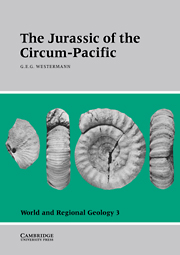Book contents
- Frontmatter
- Contents
- List of contributors
- Preface
- Acknowledgments
- Introduction
- Part I Time scales
- Part II Circum-Pacific base map
- Part III Regional geology and stratigraphy
- 4 Western Canada and United States
- 5 Meso-America
- 6 Western South America and Antarctica
- 7 Australasia
- 8 Indonesia and Papua New Guinea
- 9 Southeast Asia and Japan
- 10 Eastern China
- 11 Eastern Russia
- Part IV Biochronology
- Part V Biogeography
- Part VI Climatology and oceanography
- Appendix: Biochronology and atlas with index and guide fossils
- General Index
- Index of Guide- and Indexfossils
10 - Eastern China
Published online by Cambridge University Press: 04 August 2010
- Frontmatter
- Contents
- List of contributors
- Preface
- Acknowledgments
- Introduction
- Part I Time scales
- Part II Circum-Pacific base map
- Part III Regional geology and stratigraphy
- 4 Western Canada and United States
- 5 Meso-America
- 6 Western South America and Antarctica
- 7 Australasia
- 8 Indonesia and Papua New Guinea
- 9 Southeast Asia and Japan
- 10 Eastern China
- 11 Eastern Russia
- Part IV Biochronology
- Part V Biogeography
- Part VI Climatology and oceanography
- Appendix: Biochronology and atlas with index and guide fossils
- General Index
- Index of Guide- and Indexfossils
Summary
GEOLOGY AND STRATIGRAPHY
East China is approximately the vast area east of longitude 105°E, north of latitude 35°N, and east of longitude 97°E south of 35°N (Figure 10.1).
Later Triassic (Indo–Sinian) tectonism caused large-scale marine regression in South China and greatly influenced all of China. During the Jurassic, South China was uplifted and joined with North China to form a landmass. Terrestrial Jurassic rocks therefore predominate in East China. Marine transgressions occurred regionally in the areas of Guangdong, south Hunan, south Fujian, northeast Heilongjiang, and west Yunnan. Evidence for Jurassic in Taiwan is missing.
During the Palaeozoic and Triassic, three latitudinal tectonic belts, from north to south the Yin-shan, Qinling, and Nanling Belts, controlled geological events of East China. Since the Indo-Sinian tectonism along the western active margin of the Pacific plate, East China has been differentiated from West China. Easternmost China was under shear stress, resulting in two sets of orthogonal faults, northeast and northwest, and in many small sedimentary block basins, with active volcanism along the faults. Volcanic activity gradually increased while the depositional basins moved from west to east. Consequently, the vast area west of longitude 105°E is the Stable Giant Basin region.
Two major facies are distinguished: terrestrial and alternating marine and terrestrial, each with stable and mobile shelf environments. Many facies assemblages have also been distinguished (Table 10.1). Based on these facies, the Jurassic of East China is divided into two regions and eight districts (Figure 10.1).
- Type
- Chapter
- Information
- The Jurassic of the Circum-Pacific , pp. 214 - 224Publisher: Cambridge University PressPrint publication year: 1993



